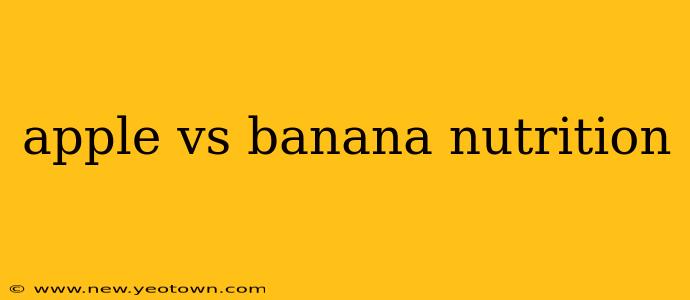So, you're standing in the fruit aisle, contemplating the age-old question: apple or banana? Both are convenient, portable, and undeniably delicious, but which reigns supreme in the nutritional battle? Let's dive into a juicy comparison, exploring the nutritional profiles of these popular fruits and answering some frequently asked questions along the way.
This isn't just about calories; it's about understanding which fruit best fits your individual dietary needs and preferences. Imagine this: You're fueling up for a morning run, needing sustained energy. Or perhaps you're looking for a quick post-workout snack packed with potassium. The choice between an apple and a banana suddenly becomes a strategic one.
Apple Nutrition: A Crisp Overview
Apples, with their satisfying crunch, offer a delightful mix of nutrients. One medium apple (about 182 grams) typically provides:
- Calories: Around 95
- Fiber: About 4 grams – contributing to digestive health and satiety.
- Vitamin C: A good source, boosting immunity.
- Potassium: Important for maintaining healthy blood pressure.
Apples are also a decent source of antioxidants, particularly quercetin, linked to various health benefits, including reducing inflammation. Their fiber content promotes gut health, helping to regulate digestion and prevent constipation.
Banana Nutrition: The Potassium Powerhouse
Bananas, with their creamy texture and sweet taste, are nutritional powerhouses in their own right. A medium-sized banana (about 118 grams) generally contains:
- Calories: Approximately 105
- Potassium: A significant source, crucial for muscle function and nerve signals. This is where bananas often outshine apples.
- Fiber: Around 3 grams – supporting healthy digestion.
- Vitamin B6: Important for brain development and function.
Bananas are also a good source of natural sugars, providing a quick energy boost. This makes them an excellent choice for pre- or post-workout snacks. The high potassium content is particularly beneficial for athletes, helping to replenish electrolytes lost through sweat.
Which Fruit Has More Fiber?
Both apples and bananas offer a respectable amount of dietary fiber, crucial for digestive health. However, apples generally contain slightly more fiber per serving than bananas. This small difference can be significant for individuals focusing on increasing their fiber intake.
Which Fruit Is Better for Weight Loss?
When it comes to weight management, both apples and bananas can contribute to a healthy diet. Apples, with their higher fiber content, might provide a slightly greater feeling of fullness, potentially aiding in weight loss efforts. However, portion control is key for both fruits. Neither should be consumed in excessive quantities.
Which Fruit Is Higher in Potassium?
Bananas are the clear winner in this category. Their significantly higher potassium content makes them an ideal choice for individuals seeking to increase their potassium intake. This is especially beneficial for athletes, those with high blood pressure, and individuals recovering from illness.
Which Fruit Is Better for Athletes?
For athletes, the choice depends on their needs. Bananas provide a quick source of energy due to their natural sugars, making them suitable for pre- or post-workout snacks. Apples, with their sustained energy release from fiber, can also be beneficial, especially for longer endurance activities. Ultimately, both fruits offer valuable nutrients to support athletic performance.
Conclusion: Apples and Bananas - A Winning Combination!
The "apple vs. banana" debate doesn't have a definitive winner. Both fruits offer unique nutritional profiles and contribute to a balanced diet. The best choice depends on your individual needs and preferences. Incorporating both apples and bananas into your diet provides a diverse range of vitamins, minerals, and fiber, contributing to overall health and well-being. So next time you're at the grocery store, grab a few of each – you can't go wrong!

